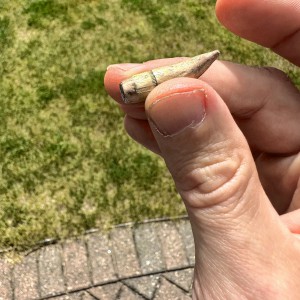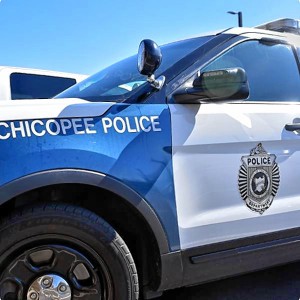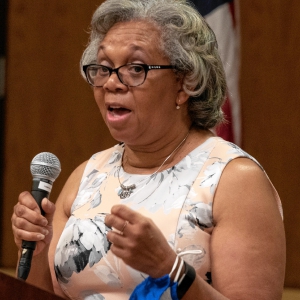Students focus on peers’ struggles: Getting to Y pilot program at Easthampton High seeks to address concerns raised in health survey
| Published: 05-31-2023 4:37 PM |
EASTHAMPTON — A yearlong pilot program called “Getting to Y” is helping a group of city high school students gain a better understanding of what their peers are going through when it comes to a variety of health-related concerns, ranging from suicidal thoughts and the unfair treatment of students of color to perceptions of substance use.
Throughout the school year, members of the Getting to Y team have been analyzing the results of Easthampton High School’s local youth health survey data. In addition to brainstorming ways to call attention to areas of concern flagged in the survey, students in the new group are also offering potential solutions that they hope will ease the minds of their classmates. Much as the group’s name suggests, the high schoolers sought to determine why students were facing such problems.
Getting to Y is overseen by the Easthampton Healthy Youth Coalition and the Collaborative for Educational Services’ Strategic Planning Initiative for Families and Youth (SPIFFY) coalition as part of a program piloted in a handful of Massachusetts schools and communities by the Department of Elementary and Secondary Education and the Bureau of Substance Addiction Services.
While most of the results of the prevention needs assessment survey were not surprising to the eight-member group, there were some startling data points, according to 16-year-old Sophie Slaghekke. For example, 25% of the 149 students in 10th and 12th grades at Easthampton High who completed the survey have seriously considered suicide within the past year. For those who identified as lesbian, gay, bisexual or transgender, the numbers were especially high.
“It’s super shocking and kind of hard to see,” Slaghekke said.
The prevention needs assessment survey, which SPIFFY administers every two years to all eighth, 10th, and 12th grade students in Hampshire County, monitors youth substance use, mental health, and other risk and protective factors, such as access, risk perceptions, parent disapproval and social support. The survey also assesses key demographic information.
For the Getting to Y team, SPIFFY provided data that was specific to Easthampton High students in comparison with the more than 1,400 respondents in other Hampshire County schools.
Since late October, the Getting to Y team, which also includes Elliott Anthony, Santana Buchanan, Jessica Cloutier, Braden Lynn, Michael Massa, Emma McMahon and Ezra Paquette, has been meeting once a week for about 45 minutes at the high school.
Article continues after...
Yesterday's Most Read Articles
 Holyoke man finds bear paw in his yard
Holyoke man finds bear paw in his yard
 Developer lands $400K loan for affordable housing project in Easthampton mill district
Developer lands $400K loan for affordable housing project in Easthampton mill district
 Petition to block auto dealership on King Street falters in Northampton
Petition to block auto dealership on King Street falters in Northampton
 Fearful Belchertown residents blame stray bullets on nearby gun club, appeal to town for help
Fearful Belchertown residents blame stray bullets on nearby gun club, appeal to town for help
 South Hadley man fatally shot in attempted robbery
South Hadley man fatally shot in attempted robbery
 First look at how little Amherst’s police alternative being used called troubling
First look at how little Amherst’s police alternative being used called troubling
The program has been implemented widely in Vermont schools and has been rated by the Vermont Department of Health as an “evidence-based” practice to empower youth as school health change agents.
Easthampton High Principal William Evans said he was pleased with how the students dug into the survey data.
“One thing we know about adolescents is that they are often more responsive to peers than to adults,” Evans said. “The fact that this group took the time to explore this data and provide ideas and potential solutions was very valuable.”
To identify the top concerns, Getting to Y facilitated a three-hour youth data event in December.
“There were different activities throughout identifying strengths in the data, identifying concerns, and then voting on what are the top strengths, what were the top concerns,” said Lexi Polokoff, policy, youth, and school coordinator for SPIFFY.
In addition to a high suicidality rate, other areas of concern identified were that transgender and nonbinary students experience high rates of anxiety and depression, students of color at Easthampton High say they experience unfair treatment from teachers and their peers, and a majority of students do not perceive alcohol or cannabis use as risky endeavors.
The group presented their concerns at a community dialogue event in April.
With few days left in the school year, Paquette says members have put a hold on making any big changes and have instead been looking into the district’s “anonymous alerts” system, accessed on the Easthampton Public Schools website under the quick links menu. The link refers users to a form for students or parents to anonymously submit suspicious activity, bullying or other student-related issues to school administrators.
Rebecca Edwards, coordinator for the Easthampton Healthy Youth Coalition who runs the after-school program with Polokoff, said Anonymous Alerts was launched before the COVID-19 pandemic. As students and community members might not be familiar with the form, Edwards said it was important for them to publicize a solution that had already been implemented.
“This is our chance to get the word out again. This is a tool that students can use to communicate things that they’re worried about,” she said.
Alternatively, the group is implementing a non-digital option with an anonymous alerts box for handwritten notes.
The group also suggests creating a pamphlet that provides information to students and teachers on what triggers so-called mandated reporting. The group has found that many students have felt held back by the protocol, which under state law requires staff members in schools to immediately make an oral report to the Department of Children and Families when they have reasonable cause to believe a child under 18 years old is suffering from abuse or neglect. A written report is then required to be submitted within 48 hours.
“I think just having that transparency of information really clearly spelled out will allow students to reach out for more help in general,” Edwards said.
Massa, 17, said he’s found several teachers to be “dismissive” and “patronizing.” He’d like to see teachers and administrators who are more welcoming.
Slaghekke said she thinks there’s a lack of training for teachers on mental health issues, specifically related to gender and LGBTQ matters, as well as an understanding of students of color being treated unfairly. She said there seems to be a lack of understanding of what to do if a student is experiencing a mental health crisis.
Both Slaghekke and Massa spoke about a survey that went out last year regarding suicidality and mental health. Students who provided answers that might be concerning were forced to talk to guidance counselors about it and didn’t consider the circumstances to be especially welcoming, Slaghekke said.
“They advertised (the survey) as anonymous, but when you got called down, it clearly wasn’t,” Massa said.
Instead, Slaghekke said that the conversation on topics like this should be more accessible, utilizing the box or the online anonymous alerts system.
Polokoff said they hope the program picks up again next year where it left off. One area of focus would be to develop strategies regarding the concerns that students of color are facing harassment and discrimination in schools. Getting to Y would like to hold focus groups in which students of color are interviewed to get a better sense of their needs and continue to build on their ideas that have been developed over the past year.
“I feel like this group is a good first step,” Paquette said. “We are kind of like the bridge between the adults and the rest of the student body. … Not everything that we’re going to do might succeed at first because like, this is a new thing that we’re trying out. I’m sure there’ll be some ups and downs, but at least we’re trying to put in the effort to create change and help build trust within the school.”
Emily Thurlow can be reached at ethurlow@gazettenet.com.
 A Look Back: April 20
A Look Back: April 20 New HCC president reflects on journey: Timmons sees his own struggles and arc in students’ paths
New HCC president reflects on journey: Timmons sees his own struggles and arc in students’ paths Historic murals restored at Victory Theatre in Holyoke
Historic murals restored at Victory Theatre in Holyoke
